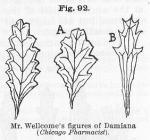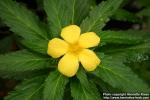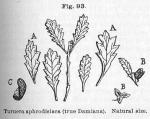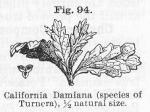
 Preparation: Fluid Extract of Turnera
Preparation: Fluid Extract of Turnera
The leaves and top of Turnera aphrodisiaca, Ward and Vasey (Turnera diffusa, Willdenow, var. aphrodisiaca, Urban).
Nat. Ord.—Turneraceae.
COMMON NAME: Damiana.
Botanical Source, History, and Description.—This drug was introduced, in 1874, by Dr. F. O. St. Clair, and first appeared in the form of fluid extract, from the firm of Messrs. Helmick & Co., of Washington, D. C. Three distinct varieties or species of plants under the name of Damiana, are occasionally found upon the market, and are derived from as many different sources. In connection with the history of this drug, it may be stated that Mr. H. S. Wellcome read a paper upon the subject before the New York Alumni Association of the Philadelphia College of Pharmacy, October 15, 1875, at the same time exhibiting cuts of leaves, which were known upon the market, at that time, as "Damiana," reproduced by us (Fig. 92).
 The true Damiana, the kind originally introduced by Dr. F. O. St. Clair, who obtained it from Mr. Eugene Gillespie, the United States Consul at Cape San Lucas, is derived from Mexico (see Fig. 93). It is evidently from a Mexican species of Turnera, supposed, by E. M. Holmes, to be a smooth-leaved variety of T. microphylla, De Candolle. Prof. Lester F. Ward, on the examination of authentic specimens obtained by Dr. St. Clair, concluded that the drug is obtained from an undescribed species of Turnera, which Prof. Vasey and himself designate Turnera aphrodisiaca, and this name we shall accept for the Mexican damiana, until further light is thrown upon the subject. The result of Prof. Ward's examination can be found in the Virginia Med. Monthly, April, 1876. We extend our thanks to Dr. St. Clair for the aid given us in our endeavor to obtain the complete history of this drug, as well as for the specimens of original damiana so kindly furnished by himself. In this connection we can say that the leaves of Fig. 93, marked A A, are drawn from the original lot of damiana imported by Dr. St. Clair, in 1872.
The true Damiana, the kind originally introduced by Dr. F. O. St. Clair, who obtained it from Mr. Eugene Gillespie, the United States Consul at Cape San Lucas, is derived from Mexico (see Fig. 93). It is evidently from a Mexican species of Turnera, supposed, by E. M. Holmes, to be a smooth-leaved variety of T. microphylla, De Candolle. Prof. Lester F. Ward, on the examination of authentic specimens obtained by Dr. St. Clair, concluded that the drug is obtained from an undescribed species of Turnera, which Prof. Vasey and himself designate Turnera aphrodisiaca, and this name we shall accept for the Mexican damiana, until further light is thrown upon the subject. The result of Prof. Ward's examination can be found in the Virginia Med. Monthly, April, 1876. We extend our thanks to Dr. St. Clair for the aid given us in our endeavor to obtain the complete history of this drug, as well as for the specimens of original damiana so kindly furnished by himself. In this connection we can say that the leaves of Fig. 93, marked A A, are drawn from the original lot of damiana imported by Dr. St. Clair, in 1872.
The genus Turnera is a small family of chiefly tropical American plants allied to the Passifloreae. The flowers are small, yellow, and, in the species that produces damiana, subsessile near the end of the short branches. The calyx is tubular, hairy externally, colored like the petals, and 5-toothed at the apex. The petals are 5, yellow, and inserted on the tube of the calyx. The fruit, specimens of which are often found with damiana leaves, are dry, 1-celled, globular, and about the size of a large hemp seed (Fig. 93, B B). They are warty and rough externally, open by 3 valves, and contain from 3 to 6 kidney-shaped seeds (Fig. 93, C, magnified), attached to 3 parietal placentae. Mexican damiana (Turnera aphrodisiaca), as found in market, consists of broken leaves mixed with fragments of the branches, and, sometimes, with seedpods. The branches have a reddish-brown bark, and are covered, when young, with white, cottony hairs. The leaves (Fig. 93, natural size (... not here, as size depends on screen resolution. -Henriette)) are less than an inch long, obovate, wedge-shape, and taper at the base to a short, slender leafstalk., when young, they are covered with a slight pubescence, but become smooth when old. They are distinctly pinnately veined, and the margin is toothed with from 8 to 10 teeth.
A variety of damiana, closely resembling the preceding, is derived from California. It was ascertained by Mr. E. M. Holmes to be obtained from Turnera microphylla, De Candolle, a small shrubby plant, native of lower California and northern Mexico. The leaves resemble the Mexican, but are broader, and covered with hairs on both sides (Fig. 92, A, preceding page).
 A second kind of California damiana (also a species of Turnera) later made its appearance in the market. We are indebted to Mr. James G. Steele for the fact that this lot of damiana came from San Diego, California, and grew inland, at the southern part of the state. The leaves have the shape of the Mexican damiana, but are larger, and very hairy, especially underneath (Fig. 94, ½ natural size, preceding page).
A second kind of California damiana (also a species of Turnera) later made its appearance in the market. We are indebted to Mr. James G. Steele for the fact that this lot of damiana came from San Diego, California, and grew inland, at the southern part of the state. The leaves have the shape of the Mexican damiana, but are larger, and very hairy, especially underneath (Fig. 94, ½ natural size, preceding page).
 The most common sophistication, however, once sold freely under the name of Damiana, is obtained from Aplopappus discoideus, De Candolle, a Compositae plant of the section Asteroideae. It is one of the few rayless species of Aplopappus, and is referred by some to the genus Linosyris. It has no botanical relation to the true damiana, and can only be considered a sophistication. The leaves (Fig. 95, natural size, and Wellcome's Fig. 92, B, preceding page) of this plant, as found on the market, are thick, firm, and not so much broken up as the Turnera; the surface of the leaf is rough, resinous, dotted, the mid-rib being prominent; but the veinlets are indistinct. The teeth are toward the apex of the leaf, and are rather remote and sharp. This plant can readily be distinguished from the true damiana by the presence of numerous flower-heads, which are common in all the specimens examined by us (Fig. 95, A). They are borne in axillary clusters of from 4 to 6 heads. The involucre is bell-shaped, and consists of numerous coriaceous imbricated scales, pubescent on the tips. The achenia (Fig. 95, B, magnified) are covered with a dense appressed pubescence, and bear a tawny, scabrous, spreading, unequal pappus.
The most common sophistication, however, once sold freely under the name of Damiana, is obtained from Aplopappus discoideus, De Candolle, a Compositae plant of the section Asteroideae. It is one of the few rayless species of Aplopappus, and is referred by some to the genus Linosyris. It has no botanical relation to the true damiana, and can only be considered a sophistication. The leaves (Fig. 95, natural size, and Wellcome's Fig. 92, B, preceding page) of this plant, as found on the market, are thick, firm, and not so much broken up as the Turnera; the surface of the leaf is rough, resinous, dotted, the mid-rib being prominent; but the veinlets are indistinct. The teeth are toward the apex of the leaf, and are rather remote and sharp. This plant can readily be distinguished from the true damiana by the presence of numerous flower-heads, which are common in all the specimens examined by us (Fig. 95, A). They are borne in axillary clusters of from 4 to 6 heads. The involucre is bell-shaped, and consists of numerous coriaceous imbricated scales, pubescent on the tips. The achenia (Fig. 95, B, magnified) are covered with a dense appressed pubescence, and bear a tawny, scabrous, spreading, unequal pappus.
The sensible properties of the leaves of all the varieties (or species) of Turnera found upon the market, under the name damiana, are similar. All have a fragrant odor, resembling lemon-balm, and a pleasant, slightly aromatic taste. The leaves impart their virtues readily to hot water, as well as to mixtures of water and alcohol. The spurious damiana, Aplopappus discoideus (Fig. 95), is entirely different. It resembles more nearly the Grindelias, both in odor and taste. It is very resinous, and imparts its characteristic properties most freely to strong alcohol. Water hardly affects it, and mixtures of water and alcohol imperfectly exhaust the resinous principles, and do not permanently retain in solution such portions as are extracted. This spurious damiana need never be unintentionally employed, as both the general appearance of the leaf, and the sensible characteristics, are entirely different from all the species of Turnera. It has been offered at half the price of true damiana.
Chemical Composition.—When distilled with water, the distillate from the leaves yields an essential oil. This oil is lighter than water, possesses the characteristic odor, and imparts to the plant its fragrance. Chlorophyll, hard and soft resin, tannin, sugar, albuminoids, gum, and ash were found by Parsons in true damiana. Potassium chloride was found in spurious damiana by E. S. Wayne, in 1876. According to a more recent analysis of the leaves of damiana, by F. W. Pantzer (Amer. Jour. Pharm., 1887, p. 69), alkaloids and glucosids were not observable. The yield of volatile oil obtained by distillation was 0.5 per cent.
Action, Medical Uses, and Dosage.—This drug has been almost eulogized for its positive aphrodisiac effects, acting energetically upon the genito-urinary organs of both sexes, removing impotence in the one, and frigidity in the other, whether due to abuses or age. Many physicians who have tried it, deny its possession of such virtues, but the friends of the drug attribute their failures to the use of the spurious articles. It will very likely be found to possess laxative, tonic, and diuretic properties only; and the aphrodisiac effects following its use, no more prove that these belong to it, than the same effects, that not unfrequently appear after the employment of many other agents prove that such agents possess similar excitant virtues. Upon the system at large, it exerts a tonic influence, and is useful in some cases of chronic cystic and renal catarrh. It relieves irritation of the urinary mucous membranes, improves digestion, and overcomes constipation in some instances. In respiratory disorders, it may be employed to relieve irritation and cough, and, by its tonic properties, to cheek hypersecretion from the broncho-pulmonic membranes. The dose of the fluid extract is from ½ fluid drachm to ½ fluid ounce; specific damiana, 5 to 60 drops.
Specific Indications and Uses.—To relieve irritation of the genito-urinary mucous surfaces. (Sexual weakness and debility, with nervousness and depression [?]).
Other Aphrodisiacs.—Hygrophila spinosa. India. Seeds reputed diuretic and aphrodisiac.
Muira-Puama.—A Brazilian wood containing an alkaloid, and reputed strongly aphrodisiac. Its botanical source is unknown (Bull. of Pharm., 1892).
 BURRA GOOKEROO.—The carpels and whole plant of Tribulus lanuginosus are said to be aphrodisiac and diuretic. A fluid extract of the fruit, in doses of 20 to 60 drops, is recommended for nocturnal pollutions.
BURRA GOOKEROO.—The carpels and whole plant of Tribulus lanuginosus are said to be aphrodisiac and diuretic. A fluid extract of the fruit, in doses of 20 to 60 drops, is recommended for nocturnal pollutions.
Sphaeranthus indicus, Mundi, Murmuria, Gorakhmundi, Kottakkarandai.—India. Contains a rich, cherry-red, volatile oil (Dymock). It is reputed deobstruent, alterative, tonic, and aphrodisiac.

